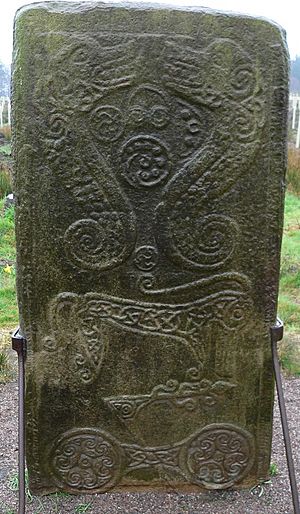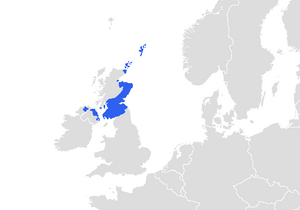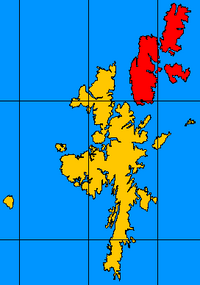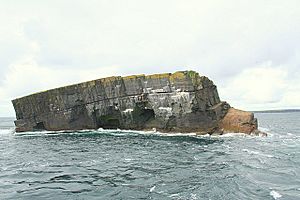Scottish island names facts for kids
The names of Scotland's islands tell a long story! They come from different languages spoken by people who lived there over many centuries. Most names in the Hebrides and Firth of Clyde come from Scottish Gaelic. But in the Northern Isles (like Shetland and Orkney), most names have a Norse origin, brought by the Vikings.
Some island names also come from English, or from an older language called Brittonic. A few names are so old that we don't know their original meaning, and they might even come from languages spoken before the Celts arrived! Since the Iron Age, these islands have been home to people speaking at least three, and often four or more, different languages. This is why many island names have more than one possible meaning today.
Scotland has over 790 islands off its coast. Most of them are found in four main groups: Shetland, Orkney, and the Hebrides (which are split into the Inner Hebrides and Outer Hebrides). There are also groups of islands in the Firth of Clyde, Firth of Forth, and Solway Firth. Plus, many small islands are found in Scotland's fresh water lochs, like Loch Lomond and Loch Maree.
The very first written records of Scottish islands were made by ancient writers from places like Rome and Greece. Many names for the bigger islands have stayed similar over time. But few names for the smaller islands from those old records are still used today. Later writers, like Adomnán and those who wrote the Irish annals, also helped us understand these early place names.
Languages That Shaped Island Names
Ancient Languages and Lost Words

People have lived on Scotland's islands since at least the Mesolithic period (a very long time ago!). This means they spoke languages and had names for the islands that are now lost to history. Proto-Celtic is thought to be the ancestor of all known Celtic languages. Some experts even suggest that some European languages have traces of an even older language family, but this idea is not widely accepted.
A few island names might have parts from these very old Celtic or pre-Celtic languages. However, we don't have much certain knowledge about any language spoken in Scotland before the Picts.
Celtic Languages: Brythonic, Pictish, and Gaelic
British (or Brythonic) was an old Celtic language spoken in Britain. It's related to modern Welsh, Breton, and Cornish. Many Scottish place names have Brythonic roots, but only a few island names do.
The Pictish language is a bit of a mystery! It was spoken by the Picts, who lived in northern and central Scotland in the Early Middle Ages. We don't have many direct writings in Pictish, so it's hard to know exactly what it sounded like. Some people think it was another type of Brythonic language. However, we do find many Pictish place names, especially in the north.
The Gaelic language came to Scotland from Ireland. This happened because of the growing power of the kingdom of Dalriada from the 6th century onwards. Today, Scottish Gaelic is still spoken in parts of the Scottish Highlands and the Hebrides. It used to be spoken much more widely across Scotland.
Norse and Norn: The Viking Influence
Old Norse was a language spoken by the Vikings from Scandinavia. They settled in many places, including Scotland, during the Viking Age (up to about 1300 AD). Their language had a huge impact on Scottish island names. This is because almost all the islands (except those in the Firth of Forth) were controlled by the Norse from the 9th to 13th centuries.

Norn was a language that developed from Old Norse. It was spoken in Shetland and Orkney. Very few written records of Norn exist. After the Northern Isles became part of Scotland in the 15th century, Norn was gradually replaced by Insular Scots, a form of the Scots language.
English and Scots: Modern Names
English is a language that developed from Germanic roots. The modern version of English we speak today started around 1550. The Scots language is closely related to English and is also important in Scotland.
Even though English and Scots are the main languages in Scotland today, they don't appear in many island names. Most names were already set by the time these languages became dominant.
First Recorded Island Names

The earliest written mentions of Scottish islands come from ancient Greek and Roman writers. Later, a document called the Ravenna Cosmography, written around 700 AD, also listed some Scottish island names. This document often used old maps as its source.
The monastery on Iona meant that life in that part of Scotland was well recorded from the mid-6th to mid-9th century. However, after 849 AD, when Columba's holy items were moved because of Viking attacks, written records from local sources almost disappeared for 300 years.
Pytheas of Massilia visited Britain between 322 and 285 BC. He described Britain as a triangle with a northern tip called Orcas. This might have referred to Dunnet Head in mainland Scotland, from where Orkney can be seen. Later, Roman writers like Pomponius Mela and Tacitus called the Orkney islands Orcades.
In 43 AD, Pomponius Mela mentioned seven islands called Haemodae, and Pliny the Elder later called them Acmodae. Both are thought to be Shetland. Pliny also mentioned 30 Hebudes and Dumna, which are believed to be the Hebrides and Outer Hebrides. Later, Ptolemy wrote about five Ebudes (possibly the Inner Hebrides) and Dumna.
For individual Hebridean islands, Islay was Ptolemy's Epidion, Mull was Malaios, and Skye was likely his Scetis.
Adomnán, an abbot from Iona in the 7th century, wrote down the names of various Hebridean islands. He knew these places well, so his records might be the first time we see names used by the islanders themselves. There are also early records from Ireland and Scotland written in Celtic languages.

The table below shows island names recorded before 1200 AD, or Norse names that were likely used around that time. The rulers of the Kingdom of the Isles (which included the Hebrides, islands of the Firth of Clyde, and the Isle of Man) were of Norse origin from the mid-9th century.
Norse settlers often changed the names they heard from local people. They made the sounds fit words or phrases in their own language. For example, Orcades (which probably meant "islands of the boar people") became Orkneyar, meaning "seal islands."
| Island or Archipelago | Classical Name | Ravenna | Adomnán | Old Norse | Celtic | Notes |
|---|---|---|---|---|---|---|
| Shetland | Haemodae/Acmodae | Hetlandensis | Insi Catt | The exact location of "Thule", mentioned by Pytheas, is not certain. Tacitus likely meant Shetland when he wrote about it in 98 AD. | ||
| Orkney | Orcades insulae | Orkneyar | Insi Orc | The Anglo-Saxon monk Bede also used the name Orcades insulae. | ||
| Outer Hebrides | Dumna | Domon/Doman | This might refer to Lewis and Harris rather than all the Outer Hebrides. | |||
| Inner Hebrides | Hebudes/Ebudes | Suðureyjar/Suðreyiar | Erdomon/Iardomon | The Old Irish Erdomon means "near" or "east of" Domon. | ||
| Lewis | Linnonsa | Ljoðhús | Leodus, Lyodus | |||
| Uists | Ívist | The original meaning of this name is unclear. | ||||
| Shiant Isles | Exosades | |||||
| Skye | Scetis | Scitis/Scetis | Scia | Skíð | Sceth, Scii | |
| Canna | Elvania | Elena | Called Kanna in Old Norse. | |||
| Rùm | Erimon | Ruim, Ruiminn | ||||
| Eigg | Sobrica | Egea | Ega, Ego | |||
| Coll | Colossus | Kolbeinsey | Also Kollr in Old Norse. | |||
| Tiree | Birila | Ethica Terra | Tyrvist | Tir iath | "Tir iath" is from the 6th century. | |
| Mull | Malaios | Maiona | Male(a) | Mýl | Muile | |
| Iona | Esse | I | Eyin helga | Iae, Ioua, Hiona-Columcille | The Norse name means "Holy Isle." | |
| Colonsay | Hinba? | The location of Hinba is not certain. | ||||
| Oronsay | Hinbina? | Eilean Orain? | Hinbina might simply mean "little Hinba." | |||
| Islay | Epidion | Elete | Ilea | Íl | Ili, Ilea, Ile | |
| Texa | Atina | Oidech/Aithche | ||||
| Jura | Saponis | Saine/Sainea | Doiread Eilinn | |||
| Gigha | Canna | Guðey | The Ravenna name might refer to Cara, near Gigha. | |||
| Bute | Botis | Bót | Bot, Bote | |||
| Arran | Manna | Herray/Hersey | Aru, Arann, Arran | |||
| Great Cumbrae | Magnancia | Kumreyar | The Norse name refers to both Cumbrae islands. | |||
| Little Cumbrae | Anas | |||||
| Ailsa Craig | Cunis | |||||
| Rathlin | Rhicina/Eggarikenna/Rignea/Ricnea | Regaina | Rechrea | Rachra, Ragharee, Reachrainn & Rechru | ||
| Man | Mona/Monopia/Mevania | Mona | Mön | Manau/Mano | Old Welsh records use the name Manaw. |
Many of the names for Scotland's largest islands have stayed somewhat similar from ancient times to today. However, the original meanings of many of these old names are a mystery. This suggests they were created very, very long ago, perhaps by the first people who settled there after the Ice Age. We don't know what languages those early settlers spoke.
Pre-Celtic Names: The Oldest Mysteries
In Shetland, three island names—Fetlar, Unst, and Yell—have unknown origins. They might be from a language spoken before the Celts arrived. While the earliest Norse records give them Norse meanings (like "shoulder-straps" for Fetlar), these don't seem like obvious names for islands. So, they were probably adapted from an even older language. This could have been Pictish, but we don't have clear proof.
Some names in the Hebrides might also have pre-Celtic origins. Even the name "Hebrides" itself, from Ebudae, might come from a very old, pre-Celtic root.
- Mull was called Malaios by Ptolemy. It might mean "lofty isle," and its origin is pre-Gaelic.
- The abbot Adomnán recorded Coll as Colosus and Tiree as Ethica. These might be pre-Celtic names.
- Islay was Ptolemy's Epidion. The "p" sound suggests a Brythonic or Pictish tribal name. Its root is not Gaelic and is unknown.
- The history of the name Skye is complicated and might also include a pre-Celtic root.
- Lewis was Ljoðhús in Old Norse. While some Norse meanings have been suggested, the name is not Gaelic, and its Norse connection is uncertain.
- The origin of Uist (Old Norse: Ívist) is also unclear.
- Rùm might come from Old Norse for "wide island" or Gaelic for "isle of the ridge." However, some experts say it's a "pre-Gaelic name and unclear."
- Seil is likely a pre-Gaelic name, though a Norse origin has also been suggested.
- The origin of Arran is also a mystery. It might have a Brythonic root meaning "high place."
Brythonic and Pictish Names

Several islands in the Firth of Clyde might have Brythonic roots. Besides Arran, Bute might have a British root, and Great and Little Cumbrae definitely do.
Inchkeith in the Firth of Forth was called "Insula Keth" in the 12th century. Its name might come from the Brythonic word coed, meaning "wood." Cramond Island in the Forth gets its name from Caer, a Welsh word meaning "stone fort."
It's believed that Pictish names were once common in the northern Inner Hebrides, Outer Hebrides, Orkney, and Shetland. However, there are not many historical records. For example, in the 6th century, the Pictish King Bridei I of the Picts likely ruled over Shetland, Orkney, Skye, and the Western Isles. But most of the old Pictish place names were lost when the Norse-speaking Gall-Ghaeils arrived in the 9th century.
Orkney's name is older than the Norse period and is Pictish. Very few Pictish place names can be found in Orkney and Shetland today. Some Norse names might even be adaptations of older Pictish ones. There are also ogham inscriptions, like on the Lunnasting stone in Shetland, which might be Pictish writing.
Norse Names: The Viking Legacy
From before 900 AD until the 14th century, Shetland and Orkney were Norse societies. The Norse also controlled the Hebrides and the islands of the Clyde for much of this time, though their power lessened after the 13th century. We don't know exactly when and how the Vikings took over the islands, but we know they raided Britain repeatedly from 793 AD onwards.
Because of this, most island names in Orkney and Shetland are Norse. Many names in the Hebrides are Gaelic versions of original Norse names. For example, the Norse ending -øy or -ey (meaning "island") often became -aigh in Gaelic and then -ay in modern Scots/English.
Gaelic, Scots, and English Names
Surprisingly, Shetland's name might have a Gaelic root. The name Innse Chat is mentioned in early Irish writings, and it's possible this led to the later Norn name Hjaltland. However, Gaelic has had very little influence on the names in the Northern Isles.
The Hebrides are still a strong area for modern Gaelic speakers, so it's no surprise that Gaelic has greatly influenced the island names there. Some experts used to think that Norse names only affected islands north of Ardnamurchan, and that Gaelic names were more common in the south. However, newer research suggests that Norse names almost completely replaced older names throughout the Hebrides. This means that Gaelic names on the southern islands likely appeared after the Norse period.
Sometimes, an island's name changed completely. For example, Adomnán recorded Sainea, Elena, Ommon, and Oideacha in the Inner Hebrides, but we don't know where these islands were. Their names must have disappeared during the Norse era. It's also possible for an island like Rona to have had a Celtic name, then a similar-sounding Norse name, and then a Gaelic name with a Norse ending.
In the Northern Isles, Old Norse is a dead language. So, names of Old Norse origin are now like loan words in the Scots language. "Muckle," meaning large or big, is one of the few Scots words found in the island names of the Nordreyar (Northern Isles). You can see it in Muckle Roe and Muckle Flugga in Shetland, and Muckle Green Holm and Muckle Skerry in Orkney.
Many small islets and rocky islands (skerries) have Scots or Insular Scots names, like Da Skerries o da Rokness in Shetland.
Great Cumbrae and Little Cumbrae have English/Brythonic names. Other examples of "great" and "little" include Great Bernera and Rysa Little. The informal use of "Isle of" is common, but only a few larger Scottish islands, like the Isle of Ewe and the Isle of May, use this formally. "Island" also appears, as in Island Macaskin. Holy Island off Arran has an entirely English name, as do the collective Small Isles. Ailsa Craig is also known as "Paddy's Milestone."
The Norse often gave animal names to islands, and these have been translated into English. Examples include the Calf of Flotta and Horse of Copinsay. Brother Isle is an English version of breiðare-øy, meaning "broad beach island." The Norse word holmr, meaning "a small, rounded islet," became "Holm" in English. There are many examples, such as Corn Holm and Thieves Holm.
Images for kids





